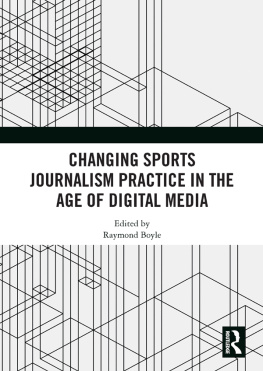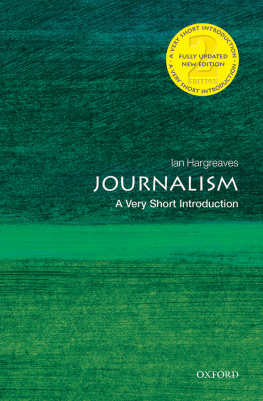Models of Journalism
Models of Journalism investigates the most fundamental questions of how journalists can best serve the public and what factors enable or obstruct them in doing so. The book evaluates previous scholarly attempts at modeling the function and influencing factors of journalism, and proceeds to develop a range of important new models that take contemporary challenges faced by journalists and journalism into account.
Among these new models is the chronology-of-journalism, which introduces a new set of influencing factors that can affect journalists in the 21st century. These include internal factors (journalistic principles, precedents and practices) and external factors (journalistic production, publication and perception). Another new model, the journalistic compass, delineates differences and similarities between some of the most important journalistic roles in the media landscape. For each new model, Peter Bro takes the actions and attitudes of individual journalists as its starting point.
Models of Journalism combines practice and theory to outline and assess existing theoretical models alongside original ones. The book will be a useful tool for researchers, lecturers and practitioners who are engaged with the ever-evolving notions of what journalism is and who journalists are.
Peter Bro is Professor, PhD and Director of the Centre for Journalism at the University of Southern Denmark. He is a board member of several journals and media companies and writes widely within the fields of journalism, media and communication studies.
First published 2018
by Routledge
2 Park Square, Milton Park, Abingdon, Oxon OX14 4RN
and by Routledge
711 Third Avenue, New York, NY 10017
Routledge is an imprint of the Taylor & Francis Group, an informa business
2018 Peter Bro
The right of Peter Bro to be identified as author of this work has been asserted by him in accordance with sections 77 and 78 of the Copyright, Designs and Patents Act 1988.
All rights reserved. No part of this book may be reprinted or reproduced or utilised in any form or by any electronic, mechanical, or other means, now known or hereafter invented, including photocopying and recording, or in any information storage or retrieval system, without permission in writing from the publishers.
Trademark notice: Product or corporate names may be trademarks or registered trademarks, and are used only for identification and explanation without intent to infringe.
British Library Cataloguing-in-Publication Data
A catalogue record for this book is available from the British Library
Library of Congress Cataloging-in-Publication Data
Names: Bro, Peter, author.
Title: Models of journalism : the function and influencing factors / Peter Bro.
Description: London ; New York : Routledge, 2018. | Includes bibliographical references and index.
Identifiers: LCCN 2017052829 | ISBN 9781138239562 (hardback : alk. paper) | ISBN 9781315295572 (ebook)
Subjects: LCSH: JournalismPhilosophy. | JournalismTechnological innovations. | JournalismHistory21st century. | Online journalism. | Reporters and reporting.
Classification: LCC PN4731 .B75 2018 | DDC 070.4/01dc23
LC record available at https://lccn.loc.gov/2017052829
ISBN: 978-1-138-23956-2 (hbk)
ISBN: 978-1-315-29557-2 (ebk)
Typeset in Goudy
by Apex CoVantage, LLC
The sales assistant in the bookstore could sense my disappointment. I had started a semester at the PhD program at Columbia Universitys Graduate School of Journalism, and I had trouble finding one of the books on the reading list. As it turned out, there were no more new copies of the book, so the sales assistant suggested I go down to the basement of the bookstore where they stored all the used copies. Responding to my disappointment, she noted that used books also had advantages. Earmarked pages, underlined sentences and notes in the margins could not only help me find the most important parts of the book but also give the book an even greater value, since the readers might have invested their own thoughts literately on top of those of the author. Her point gave me an epiphany, and I still remember the result today. I started skimming through all the used copies in search of the book that was marked in the most inspirational way for me. For the sales assistant was right. Even though all of the books had the same cover and the same preprinted text, the old copies varied greatly when it came to the thoughts readers had included in them.
Since then, I have bought many books both old and new and even if the sales assistant might only have offered me a well-known sales pitch in the book industry, I have come to believe that the process of overwriting typifies scholarly work when it is best. Doing research might not be a question of standing on the shoulders of colleagues with great stature, as Isaac Newton put it. It might be more correct to note that research is a question of writing on top of each other. With that in mind, I see my bookshelves as offering visible proof of those past and present colleagues that have come to offer me the greatest inspiration, and some of my most overwritten books are works by the late James Carey, who, incidentally, was kind enough to invite me to spend a semester at Columbia University, and who originally sent me off to the university bookstore. Since I was the first PhD student in journalism in Denmark, there were no relevant courses to follow at home and only a few colleagues to engage with, so Carey invited me to spend a semester in New York, where I could follow his classes and that of other prominent professors at the campus grounds on the Upper West Side of Manhattan.
That semester left its mark on me and my bookshelves and even today, more than a decade later, I can detect the inspiration on the pages of some of the new and old books I bought at the time. The book most worn out from earmarks (both at the top of the pages and at times at the bottom of the pages) and with the most notes, underlines and other marks of important points contains an essay where Carey reminds us of the need to continually repair or even recast our maps, models and other types of symbolic representations of the world. [T]he purpose of the representation is to express not the possible complexity of things but their simplicity, starts a passage I have underlined twice. In the following pages of the book, Carey describes how some representations are surely more meaningful than others, and he suggests that researchers continuously strive to develop new representations that configure the most important features of an ever-changing world. This was scholarly work that he took upon himself in his more than hundred publications, but since his passing, he has left this important work for other, later generations of researchers to continue.
This book is an attempt to follow his call for scholarly action, and even if there are no handwritten scribblings in the following chapters, the references on every page and in the reference list in the back of the book are testimony to the fact that this book is written on top of the work of many others. Most of these inspirational texts contain attempts to model the function and influencing factors of journalism, and many of these writers have come to inspire the ways in which researchers around the world think about journalism and journalists. This book attempts to do the same, but is also written with others in mind: both contemporary journalists in todays newsrooms and future journalists who still reside in classrooms. For over the years, as a researcher, lecturer, director of a journalism school and a board member of media companies, I have come to find that we need new models that can not only help our understanding of the function and influencing factors of journalism in the 21st century but also help journalists understand how they and we might act in light of those factors that can both hinder and help journalism service the public.






